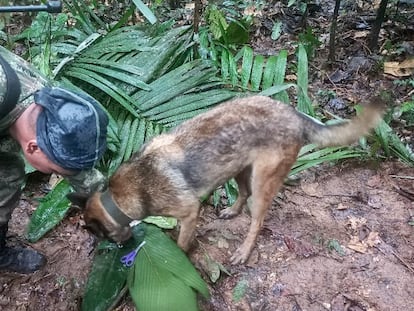‘The children missing in the jungle are alive. If they were dead, we would have found them by now’
Pedro Sánchez, commander of special forces, is in charge of the search for four minors who went missing a month ago, when their plane crashed in the Colombian rainforest


Sometimes he wakes up startled in the middle of the night, tormented by a question: where are the children? Special Forces Commander Pedro Sánchez is in charge of the search for four indigenous children who have been missing for a month in the Colombian jungle. The children were flying with three adults in a small plane that crashed due to engine failure. When the plane was found days later, only the bodies of the adults were found: there was no trace of the children. It is believed that since the plane crash, the four have been wandering through the forest — a jungle so thick that hardly any light makes it through the thick canopy, where trees soar 50 meters high, and where poisonous snakes and jaguars lie at their feet. In a place where it never stops raining. Sanchez, 50, says searching for the children is not a case of looking for a needle in a haystack, but rather something much more difficult: chasing shadows in the dark.
Question. What is your hypothesis about what happened before and after the plane crash?
Answer. The truth is that it goes against the logic of an accident. The pilot reported an engine failure and was never heard from again. The plane tried to land in a river, but it did not make the glide path and crashed into the trees. It seems unlikely that with such a strong impact, the three adults would be killed, and the four minors would be unharmed. But that was the case. There are no traces of their blood at the site.
Q. Why do you think they are alive?
A. Their bodies have not turned up, I’m sure we would have found them by now if they were dead. Instead, we have come across footprints and signs that they are alive. We recently found a footprint and compared it to a soldier’s boot. This one was much smaller. It could belong to the 13-year-old girl — her siblings are nine, four and a one-year old. We found diapers used by the baby, a bib, sneakers, a hair bow. It shows they were there.
Q. Where do you think they went?
A. They took a direction heading toward the west, oriented by the rays of the sun. On that route they found creeks that they could have followed, until they reached a river, the Apaporis. We have analyzed where they were most likely to be, but we have not found them. We decided to comb the jungle meter by meter. The men walk about 10 meters apart from each other. In the jungle, which is virgin, where there are trees 40 and 50 meters high and where it is difficult for the sun’s rays to enter, a man can get lost if he is 20 or 30 meters away. If someone moves away, they are swallowed up by the jungle.
Q. How extensive is the search area?
A. When we started, it was about 342 square kilometers [132 square miles]. Now, we are talking about 20 square kilometers [8 square miles]. Our teams have walked more than 1,400 kilometers [540 miles] in a straight line in the search. The distance between Madrid and Paris, if I’m not mistaken. It is not easy to find them. We were 100 meters away from them, we don’t know if at the same moment or a day before or after, but that’s what the tracks and our GPS told us. Why didn’t we find someone who was 100 meters away? Because you can’t see anything 20 meters away. We’re not on a golf course. Why don’t we hear anything? Sharp rain makes it difficult to hear and detect movement.
Q. Are there tracking teams at night?
A. It’s more complex, but it’s also done [at night]. But it is always raining. It is a matter of searching when there are the best conditions. You can’t hear anything with the noise. We use flares at night that we launch from airplanes.
Q. Is it true that you have found a shelter made by the children?
A. Yes, two shelters, made with palms, with leaves from the jungle that they cut to cover themselves from the rain.
Q. How are the children managing to survive in such an adverse environment?
A. The children are indigenous and have knowledge of the jungle. But it’s very difficult, as there are a lot of the dangers. They come across jaguars, ocelots, snakes and poisonous plants. It is a totally inhospitable environment. But we are keeping our faith intact. We have found signs that they are alive. There are other cases like that of a small plane lost in the jungle in Brazil. The pilot turned up 36 days later.
Q. How far do you think the children travel per day?
A. Between 200 and 500 meters a day. It’s not looking for a needle in a haystack, but rather a tiny flea in a huge carpet.
Q. What are the chances that they were found by an isolated tribe?
A. For now, that has been ruled out, as we did not find adult footprints next to their footprints. We do not believe that any narco-criminal group [referring to the FARC dissidents, composed of guerrillas who did not demobilize] has them either. Near where the plane went down, we found one of the [FARC] camps, where they made uniforms.
Q. Why are you so sure of that?
A. We have intelligence.
Q. Have you investigated the possibility that the children never got on the plane?
A. We investigated the possibility and they did board the plane. What’s more, we found their belongings, such as the sneakers, the baby bottle...
Q. How many troops are on the ground combing the jungle?
A. In total, 184 people. There are 112 of us and 72 indigenous people.
Q. The indigenous people move more easily through the jungle because they know it well.
A. They understand the jungle better than us, they know how to interpret the tracks very well. One of them found the plane. Of course, they are limited because they don’t have enough technology. They can also get lost, of course. In the jungle, they need food and medicine to prevent diseases such as leishmaniasis, which is caused by a mosquito bite and produces a fever that can lead to death.
Q. I have heard you say that you have tried everything. What else can be done?
A. A lot of people tell us do this, do that. But we have tried everything. We have tried to be creative, to do things that aren’t in the manuals. For example, we use tape similar to construction tape to mark where we go. We put it 60 centimeters [34 inches] above the ground so that the children can see it, and we hung whistles on it so that they can make noise, and we can reach the children [if they sound the whistles]. We have also erected a kind of lighthouse that has a light and speakers that broadcast messages from the children’s grandmother telling them to stay put. We play sounds of domestic animals, such as chickens, so that they think there is human life. From the air, using two Blackhawks and nine other aircraft, we have dropped 10,000 flyers in the indigenous language and food kits. These aircraft have thermal, photographic and satellite detection capabilities.
Q. How long can the search go on for?
A. We will end the mission when we find the children, or when logic and good sense indicate otherwise. In other words, when the time they could survive in the jungle has passed or when we have covered all the area where they could be found.
Q. The children’s father, who lost his wife in the accident, has joined the search.
A. That’s right, he has been searching for 12 or 13 days.
Q. Is it possible that the children will never be found?
A. Failure is not an option for us.
Q. Colombian President Gustavo Petro received information, which turned out to be wrong, that the children had been rescued and were sailing in a boat on a river. Where did that rumor come from? Was there any truth to it?
A. I can only speak to the evidence that I have found, and that was not it.
Q. How do you explain the survival of a baby barely a year old?
A. There is less likelihood [of survival] than for an adult, but until we discover otherwise, the baby is as alive as the rest of them.
Q. Petro said that finding the four children is an absolute priority for the country. Do you feel under pressure?
A. No, just the pressure of finding the children as soon as possible. They are the most important thing.
Sign up for our weekly newsletter to get more English-language news coverage from EL PAÍS USA Edition
Tu suscripción se está usando en otro dispositivo
¿Quieres añadir otro usuario a tu suscripción?
Si continúas leyendo en este dispositivo, no se podrá leer en el otro.
FlechaTu suscripción se está usando en otro dispositivo y solo puedes acceder a EL PAÍS desde un dispositivo a la vez.
Si quieres compartir tu cuenta, cambia tu suscripción a la modalidad Premium, así podrás añadir otro usuario. Cada uno accederá con su propia cuenta de email, lo que os permitirá personalizar vuestra experiencia en EL PAÍS.
¿Tienes una suscripción de empresa? Accede aquí para contratar más cuentas.
En el caso de no saber quién está usando tu cuenta, te recomendamos cambiar tu contraseña aquí.
Si decides continuar compartiendo tu cuenta, este mensaje se mostrará en tu dispositivo y en el de la otra persona que está usando tu cuenta de forma indefinida, afectando a tu experiencia de lectura. Puedes consultar aquí los términos y condiciones de la suscripción digital.
More information
Archived In
Últimas noticias
Tiger Woods turns 50: Will he continue playing on the PGA Tour or take a back seat?
The surreal journey of James Nnaji, the Barcelona youth player selected in the NBA Draft who ended up in the NCAA
Trump claims peace in Ukraine is near, but Moscow suggests otherwise
A survivor’s account of the Interoceanic Train accident: ‘We were scared because of the speed on the curve’
Most viewed
- Oona Chaplin: ‘I told James Cameron that I was living in a treehouse and starting a permaculture project with a friend’
- Reinhard Genzel, Nobel laureate in physics: ‘One-minute videos will never give you the truth’
- Why the price of coffee has skyrocketed: from Brazilian plantations to specialty coffee houses
- Pablo Escobar’s hippos: A serious environmental problem, 40 years on
- Chevy Chase, the beloved comedian who was a monster off camera: ‘Not everyone hated him, just the people who’ve worked with him’










































